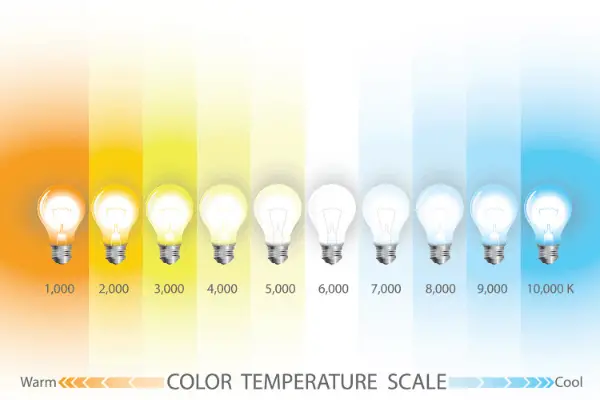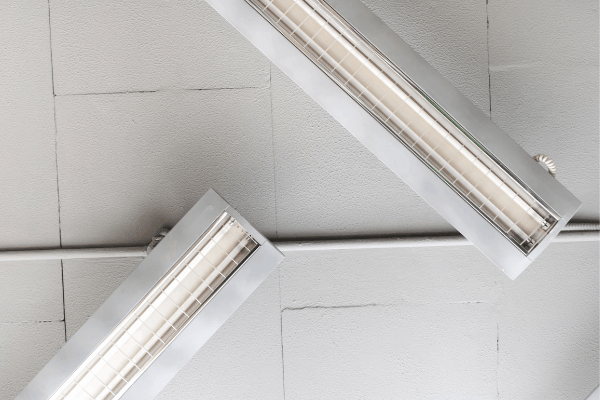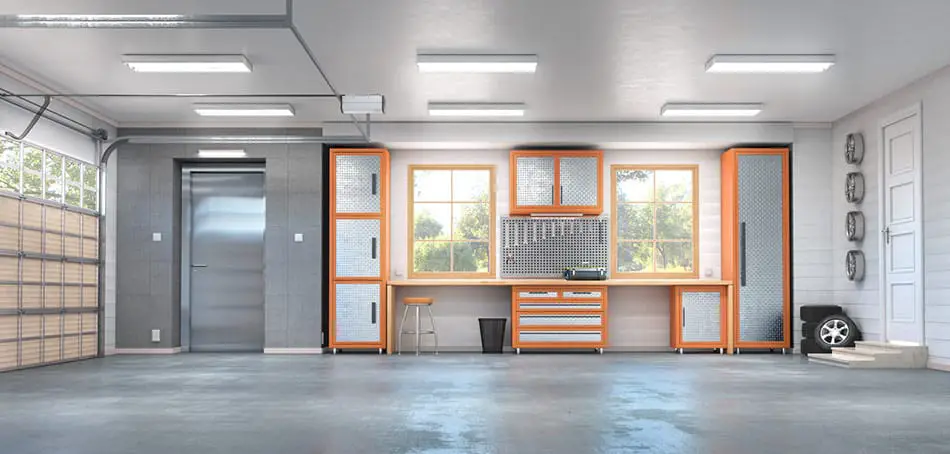Most garages in today’s world are being used for more than just storing family vehicles, and lighting is often overlooked. Garages are used as shops, storage, recreation, and workspaces, and it’s important to have proper lighting. Having the proper lighting is not only the right thing to do from a safety perspective, but it also can brighten up your mood, especially if you spend as much time in your garage as I do. This guide will help you determine how much lighting you need for your garage.
Lighting experts recommend a residential garage to have anywhere from 80-100 lumens per square foot for general overhead, ambient lighting. For a 24’x24′ 2-car garage (576 square feet), a total of 46,000-57,600 lumens are recommended.
Having the proper lighting is very important, especially if you’re using your garage as a shop — fixing cars, woodworking, or any type of fun tinkering. Poor lighting can cause eye strain, reduce productivity, introduce safety hazards, and can also have negative effects on your mood. Knowing the number of lumens you should target will give you a general idea of how many lights you’ll need. There are a number of different ways to light your garage, so let’s talk through a few guidelines to help you as you plan.
How Many Lumens Do I Need for my Garage?
In order to understand lumens, you’ll also need to understand what a foot candle is. A foot candle is a measurement that tells you how bright a light source is when you’re one foot away. One foot candle equals one lumen per square foot. To give you an idea, these are some recommended foot candles per room:
| Room | # of Foot Candles |
|---|---|
| Workspace or garage | 80-100 foot candles |
| Kitchen work areas | 70-80 |
| Kitchen general space | 30-40 |
| Bathroom | 70-80 |
| Home office | 60-80 |
| Dining Room | 30-40 |
| Living Room | 10-20 |
| Bedroom | 10-20 |
| Hallway | 5-10 |
To calculate how many lumens you should have, measure your garage width and length, then multiply to get the square footage. Once you have the square footage, multiply that by your target total lumens. Using 80-100 lumens per square foot as our example, see below for some popular garage dimensions:
| Garage Size | Square Footage | Target Total Lumens |
|---|---|---|
| 12’x24′ | 288 sq. ft. | 23,000-28,800 |
| 14’x28′ | 392 sq. ft. | 31,360-39,200 |
| 20’x20′ | 400 sq. ft. | 32.000-40,000 |
| 22’22’ | 484 sq. ft. | 38,720-48,400 |
| 24’x24′ | 576 sq. ft. | 46,000-57,600 |
Plan Your Lighting
Now that you know how many lumens you should target, you can carry on with a few more steps. As with many projects, it’s important to plan your garage lighting with a specific layout in mind. There are some general guidelines to be mindful of as you’re planning and choosing your garage lighting.
- Determine how many lumens you’ll need for your garage lighting. Again, for a residential garage or shop, anywhere from 80-100 lumens per square foot is a great target.
- Understand lighting color temperature and what works best for a garage. Down below we’ll discuss color temperature in more depth, but it’s 5000K is recommended for garage or shop lighting.
- Plan your garage lighting layout. Start with overhead or ceiling mounted fixtures as your base. Then look for opportunities to add any task or accent lighting to areas that require that type of lighting.
- Choose your fixtures. Further down in this article, we’ll review the different types of light fixtures that are available on the market and talk about where they are best used.
What’s the difference between Lumens and Watts?
Simply put, lumens are a measurement of brightness in a light. Watts measure how much energy is used. Ever since energy-efficient LED lights were introduced, watts were no longer an effective way of indicating the brightness of a bulb. Instead, lumens are what you want to pay attention to for measuring brightness.
Lighting Color Temperature
After lumens, the second key factor to consider when choosing a light bulb is the lighting color temperature. This is an indication of how warm the color is, ranging from yellow to white, which is measured on the Kelvin scale.

- Warmer, yellower lights are on the lower end of the scale (2700K to 3200K)
- Pure white light is around 4000K
- Colors that simulate daylight are rated at 5000K or even higher
For garage lighting, stick to around 4000-5000K, which is a pure white or daylight glow.
This temperature is pretty bright and good for schools, offices, lobbies, and garages.
Type and Function: Ambient, Task and Accent Lighting
Light fixtures fall into one of three categories: ambient, task, and accent. Just like many rooms in your house, ideally, your garage should use all forms of lighting.

- Ambient lighting: Softer, overhead lights that cast evenly across the garage floor. These are your larger, flush-mount fixtures like strips lights that you’ll mount to your garage ceiling.
- Ambient lighting is recommended at 80-100 lumens per square feet.
- Task lighting: Used to focus directly on work areas. These are good fixtures for workbenches or any other area that needs direct light.
- For task-oriented areas, you can go all the way up to 300 lumens per square foot. There are certain fixtures that can brighten up your workspace.
- Accent lighting: Used for showcasing details, such as decorative displays or other prizes in your garage.
- 70 lumens per square foot is generally a good rule of thumb for any accent lighting you may have.
Light Bulb Types: LED vs. CFL vs. Incandescent
Incandescent lighting is what we all remember from our childhood. It’s the standard light bulb from back in the day. CFL, or compact fluorescent lights, use less energy than incandescent, but can also take a little while for the light to warm up and reach full brightness.
LED lights require less energy than incandescent or fluorescent lights. They’ll save you a ton of money on your electric bill and last for years. By far the biggest bang for your buck is going to be LED lights of some kind. They are the newest technology, cheapest, most energy-efficient and will last for years.
Recommendation: Go with LED and don’t even think twice.
Plan Your Lighting Layout
Plan your garage lighting with the layout in mind. There are different areas you should focus on:
- Overhead lights: generally mounted or hanging from the garage ceiling
- Clamp-on lights: Clamp lights are very versatile because you can move them around and clamp to different areas.
- Tasks lights: Focused directly on a work area
- Under-cabinet lighting: LED strips are a great option for this. You’ll often see this used on kitchen cabinets as well.
- Space above the garage door
- Workbench or desk
- Wall space where items may be hanging
- Storage areas
- Exterior doors and directly outside your garage
Different Garage Light Fixtures
There are many different lighting fixtures to choose from for your garage. Let’s take a look at each of them.
- Ceiling and Wraparound Lights: These are best for your typical size garage or workshop. These will either be flush mount or hang from a chain from your ceiling.
- Commercial Bay Garage Lights: These fixtures are best for large garages with very high ceilings. They are often what you’ll see used in large warehouses.
- Shop lights: Typically a smaller, single light bar. These are great for ceilings or workbenches.
- Bar and Strip Lights: These are fairly easy to install and come in all different sizes, allowing you to fully customize your garage lighting.
In Conclusion
I recommend starting with some great LED ceiling-mounted lights. Arrange those appropriately around your garage ceiling according to how many lumens you calculated. After that, focus on task lighting for your workspaces, which will greatly improve you’re working area. Finally, consider any accent lighting you’d like to bring in to help brighten the mood a bit!
I hope this guide was useful. I know when I was building my new house and garage, I didn’t initially consider all of these factors. With my next build, I’ll be much more informed and have a better understanding of how much lighting I’ll need, and how to plan accordingly.
Now that you have a better understanding of how much lighting you’ll need for your garage, go out there and light it up!

